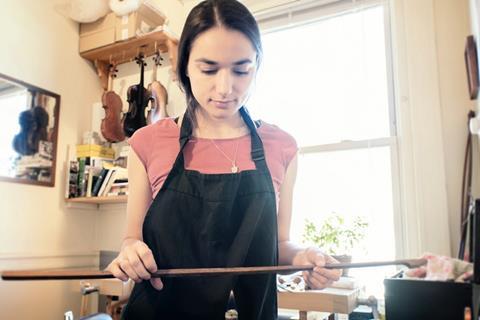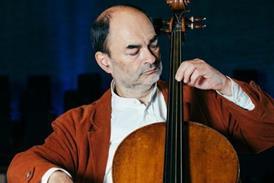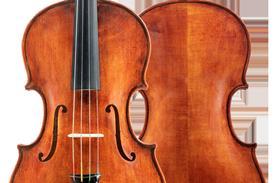Are you considering upgrading to a better bow but not sure where to start? Violinist and bow maker Mariia Gorkun gives practical advice on how to go about choosing the right bow for you and your instrument – Register for free to read

Throughout my musical career, which included two Masters in violin performance, decades of taking part in professional ensembles and orchestras and countless tours around the world, I was on a constant hunt for a better tone from my instrument. I tried different strings and rosin, I pestered violinmakers for better soundpost adjustments, I got a special string adjuster that was 50% lighter than the one I had. In search of better sound I found out that the density and amount of wood in my chinrest affected the tone. And in all my searching, my bow somehow escaped my attention.
Of course, I knew that different bows played differently. But if I tried my stand partner’s bow at the orchestra rehearsal, I would focus on how well it played spiccato or staccato, not particularly listening to how the sound of my violin was different.
I was oblivious, until I got into making bows with David Hawthorne, who was giving summer workshops in bowmaking. By that time I already had my violin repairing shop in Kiev, and was trying to keep up with my full-time orchestra job and getting torn between rehearsals and rehairs. As a professional musician and a violinmaker, I assumed I had an idea of how to achieve a good tone, and it was mainly through adjusting something on the instrument. But David’s workshops changed my understanding of the role a bow played in the process of producing sound.
Since then I became interested in how one could find a perfect matching bow for a particular instrument. I helped my customers and orchestral colleagues choose new bows by watching them play, listening to the sound, playing myself, asking advice, and trying to come up with a working system for a successful bow hunt.
With this in mind, I’ve developed a set of guidelines for how anyone can find their dream bow. They are simple, yet crucial, and following them brings great results. These suggestions can be useful for players of any level who are ready to level up their equipment — amateur, student or professional.
1 Bring your instrument. As obvious as it seems, this is essential for a player looking for a new bow. The bow should complement the sound of your specific violin, viola or cello, not your friend’s or the shop instrument. For instance, a dark sounding violin may achieve brighter tone if paired with an edgy sounding bow, or an instrument that lacks sweetness of a tone may sound better with a flexible bow. So, make sure you try bows playing your own instrument.
2 Make sure your instrument is in good adjustment and the strings are not too old. ‘When was the last time I had my violin adjusted?’ is very the first thing you want to ask yourself before heading to a shop full of unexplored bows. Bows can compensate for or enhance little imperfections in the instruments’ adjustment. When a customer comes in to try bows in our shop, often we begin by looking over the violin and, for instance, straightening the bridge – with this simple correction, the sound of the violin can improve greatly. Keep that in mind; you want to have your instrument at its best when you try new bows so the ear is not deceived by the sound imperfections. So, at this point it would be worthwhile spending time and money adjusting the soundpost or putting on a fresh set of strings, otherwise you might choose a bow that matches your poor set-up, not your violin at its best.
3 Don’t try more than a few bows at a time. Auditioning bows may get overwhelming, especially if you have to go through a large number. Usually at the shop you are asked for your price range and shown up to ten bows in your price category to choose from. Try to limit your time playing each bow – often your concentration runs out if you spend too much time trying just one bow. Focus on selecting two-three of your favourites and then compare them.
4 Bring a friend who plays the same instrument or ask the sales person to play for you. In the end, what matters the most is how the bow sounds from the outside, not how you perceive its sound under the ear. Of course, it will sound different with someone else playing your instrument, but you will at least get an idea of how the bow works with your instrument.
5 When trying bows, look for the sound first and only then focus on how comfortable it is to play. You’ve spent countless hours playing and your muscles are used to your old bow, so it may take some time to get rid of the old patterns. Often our customers would try strokes first and look for the most ‘springy’ bow, but in our practice we found that the sound of the bow is the most valuable part. The sound is the most permanent characteristic of the bow, because it depends on the quality of the wood and workmanship. A good musician can find a way to play strokes on practically any bow, but the sound producing qualities will be more or less specific to the bow.
6 Try different tension on the bows you play. Not all players are lucky to start with amazing equipment; not all parents can afford a pricey instrument. Most beginners have struggled with a student rental violin or cello before their parents recognize that music is more than just another activity. Often student-level bows lack qualities of professional bows, and the player is apt to overtighten the hair to compensate for the weakness of the stick. Doing that makes it possible to play articulated strokes, but then overtightening turns into a habit. Picking up an unknown bow, the player will turn the screw until the bow looks familiarly tight and, as a consequence, compromises its flexibility and sound properties. In general, a less tight bow has a warmer, more beautiful sound, and a tighter bow bounces better. The perfect tightness of any bow will be a balance between these properties, and is individual for each bow and player.
7 Take two or three of your favorite bows for a trial for at least a week. As we established before, your muscles are so used to your old bow that it will take some time to fully explore what a different bow can do for you. The usual practice for a bow shop is to let the customer try bows for up to 14 days, which gives enough time to choose the bow that suits the player and instrument the most. It should also give you time to take it to a lesson and get your teacher’s opinion.
8) Try the bows in different settings. Bring the bows you took out to try to an orchestra rehearsal or a chamber group to see how they feel. Take the bows to a concert hall to try the sound in the acoustic where you might play your recital. Play in different rooms, the one you practise in, a rehearsal room. If you particularly like a bow, try it in performance, if given the opportunity.
9) Don’t be distracted by cosmetic differences. One of the most common questions from customers looking for a new bow is whether there is a difference between round and octagonal bows and if the form of the stick affects the sound and playability of the bow.
As a maker I realise that not every player is aware that any bow is made octagonal first and then either left octagonal or rounded. Nevertheless, from a bowmaker’s point of view, finishing an octagonal stick is a more demanding task, because it calls for making every facet perfectly flat and straight. The bowmaker is actually obliged to spend more time making an octagonal stick than a round one. That’s why most of the famous French bows after a certain era are round, since the makers were forced to produce bows at certain speed to make a living. On the other hand, the best German bowmakers preferred to show their craftsmanship and precision by making their best bows octagonal.
There is a certain prejudice against octagonal bows in Western Europe and the US, as most musicians agree that the best bows are French and, as we already know, most of them are round. You will find the exact opposite point of view in post-Soviet countries, where teachers would recommend that their students get octagonal bows. The reason for that is that ex-Soviet countries used to be a large market for German bows, the best of which were octagonal. In any case, to choose the perfect bow one should not fall into historically conditioned misinterpretations, but should seek a bow that sounds the best for one’s instrument.
10 Be aware what your budget can realistically get you – and old isn’t always better. Usually the first thing to consider when purchasing a bow is the available budget. If the budget is below or around $1,000, you might get a better deal purchasing a Brazilian bow, which are usually made out of nice pernambuco — the source of the material being right where the bows are made. $3,000-$4,000 might get a decent German bow, which is a great choice for a student or an amateur. If you plan to spend more than $5,000, you would have a quite wide range of choice of bows made by excellent contemporary makers, as many professionals choose to do.
After breaking the waterline of $10,000 you could find an old, unattributed French bow or fancy German bow. Going to $15,000 and up might bring a named and certified old French bow, and once you’re into this territory, authentication becomes a complicating factor. Some antique master bows are certainly special and worthy of their price, but that is another discussion. More expensive bows, ideally, should offer a more refined sound, evenly over the instrument’s range, and a wider range of tone colours, but price is no guarantee of suitability for a particular player or instrument. Nevertheless, the same criteria apply to playing and choosing your bow, whatever the price.
As we can see from this calculation, purchasing a new bow from a contemporary maker can get a musician to the next level of the equipment without breaking the bank. A bonus to getting a new bow from a maker is the possibility of immediately addressing any problem, whereas a dealer without a bowmaker in their shop might be reluctant or unable to fix a problem.
To summarise, the approach you should take to choosing a bow is to make sure your instrument is well adjusted, choose bows for sound, rather than ease of execution of certain strokes, and audition your best choices long enough for you to adjust to the bow and what it can do for you when your muscles adapt to the character of that stick. This is a good method for assessing bows in any price category for any level of player and instrument.



































4 Readers' comments